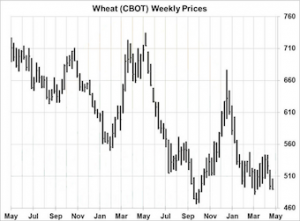- CBOT markets, with just under an hour to go, have all moved into the red as an early rally failed ostensibly on news that the Argentine government called an end to the transport and crush strike, which put support into markets yesterday. The treat by the government to take assets from crushers and exporters in a bid to keep product flowing demonstrates quite markedly how intent they are on ensuring revenues continue to accrue from export taxes. On the back of the news the bulls rushed for the door marked “exit” and focus returned once again to plentiful old crop stocks and favourable new crop growing conditions.
- Global FOB grain prices have pushed to fresh lows in Black Sea and S America with offers for both wheat and corn at 12 month lows. Exporters are pricing in an effort to search for demand, which remains limited at present.
- The USDA has today released its weekly export figures as detailed below:
Wheat: 403,700 mt, which is above estimates of zero-100,000 mt.
Corn: 945,800 mt, which is above estimates of 500,000-700,000 mt.
Soybeans: 314,900 mt, which is above estimates of 50,000-250,000 mt.
Soybean Meal: 137,200 mt, which is within estimates of 100,000-200,000 mt.
Soybean Oil: 31,800 mt which is above estimates of zero-20,000 mt.
- Interestingly the above figures mask a key piece of data, that being current year (old crop) wheat sales were a net minus 449,200 mt, which reflects record cancellations for the week. (New crop soybean sales were also negative). The old crop wheat news was hardly a bullish input to the market and together with falling world FOB levels and the likely removal of the Russian export tariff paints a bearish picture and has helped to push prices more that 2% lower. In the absence of S American export delays we look for CBOT soybeans (basis July ’15 contract) to retest the $9.50 lows set on 10 April.
- Brussels has issued yet another ½ million plus weekly wheat exports with this week’s total hitting 634,021 mt, which brings the season total to 29,327,748 mt. This is 2.76 million mt (10.37%) ahead of last year’s record pace.
- An interesting scenario is starting to unfold as Senalia, the major Rouen based export silo and delivery point for Matif wheat, announced tonight that it was halting wheat intake until further notice due to lack of vessels and/or load out programme. The silo has a capacity of around 250,000 mt and open interest on May ’15 Matif wheat, which expires 11th May, is 24,000 contracts (1.2 million mt). Given this news and the two month high in the €uro as well as the fall in Chicago it has to be noted that Matif wheat’s performance today is difficult to fully comprehend.








